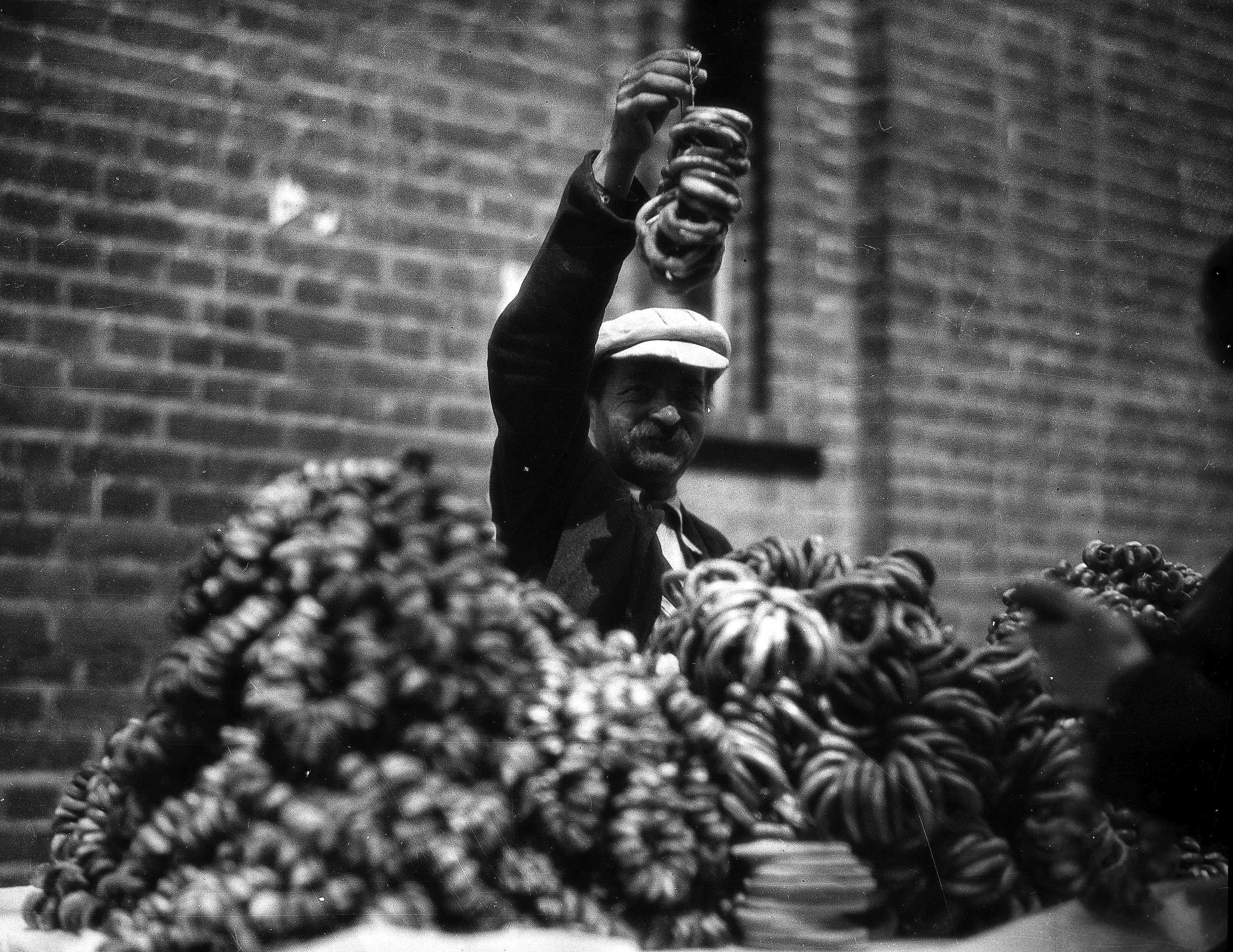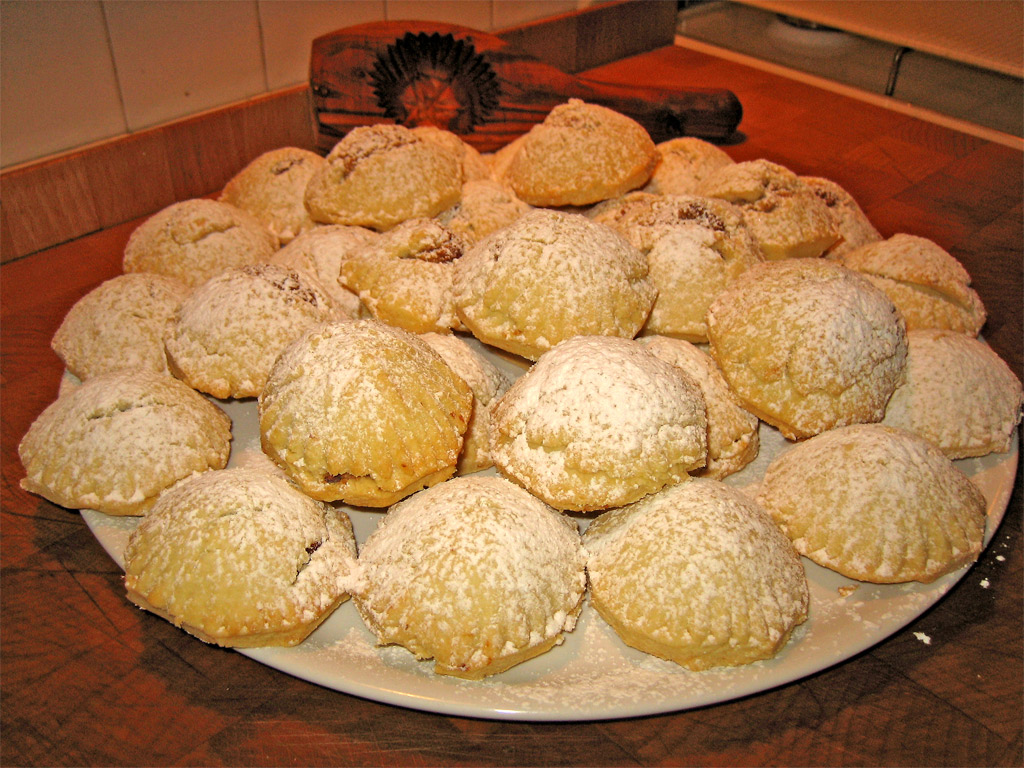|
Kandil Simidi
Kandil simidi is a salty variant of the Turkish simit pastry which is eaten during the Kandil religious holiday. It is ring-shaped and coated in sesame seeds, and is sometimes flavoured with mahlep. During the five nights of Kandil, these pastries are baked and offered to neighbours and relatives. See also * Bagel * Bublik * Ka'ak * List of pastries This is a list of pastries, which are small buns made using a stiff dough enriched with fat. Some dishes, such as pies, are made of a pastry casing that covers or completely contains a filling of various sweet or savory ingredients. There are fi ... References Sesame seed breads Turkish cuisine Holiday foods {{Turkey-cuisine-stub ... [...More Info...] [...Related Items...] OR: [Wikipedia] [Google] [Baidu] |
Bread
Bread is a staple food prepared from a dough of flour (usually wheat) and water, usually by baking. Throughout recorded history and around the world, it has been an important part of many cultures' diet. It is one of the oldest human-made foods, having been of significance since the dawn of agriculture, and plays an essential role in both religious rituals and secular culture. Bread may be leavened by naturally occurring microbes (e.g. sourdough), chemicals (e.g. baking soda), industrially produced yeast, or high-pressure aeration, which creates the gas bubbles that fluff up bread. In many countries, commercial bread often contains additives to improve flavor, texture, color, shelf life, nutrition, and ease of production. History Bread is one of the oldest prepared foods. Evidence from 30,000 years ago in Europe and Australia revealed starch residue on rocks used for pounding plants. It is possible that during this time, starch extract from the roots of plants, such as c ... [...More Info...] [...Related Items...] OR: [Wikipedia] [Google] [Baidu] |
Sesame Seed
Sesame ( or ; ''Sesamum indicum'') is a flowering plant in the genus ''Sesamum'', also called benne. Numerous wild relatives occur in Africa and a smaller number in India. It is widely naturalized in tropical regions around the world and is cultivated for its edible seeds, which grow in pods. World production in 2018 was , with Sudan, Myanmar, and India as the largest producers. Sesame seed is one of the oldest oilseed crops known, domesticated well over 3,000 years ago. ''Sesamum'' has many other species, most being wild and native to sub-Saharan Africa. ''S. indicum,'' the cultivated type, originated in India. It tolerates drought conditions well, growing where other crops fail. Sesame has one of the highest oil contents of any seed. With a rich, nutty flavor, it is a common ingredient in cuisines around the world. Like other foods, it can trigger allergic reactions in some people. Etymology The word "sesame" is from Latin ''sesamum'' and Greek σήσαμον : ''sēsamon ... [...More Info...] [...Related Items...] OR: [Wikipedia] [Google] [Baidu] |
Simit
Simit is a circular bread, typically encrusted with sesame seeds or, less commonly, poppy, flax or sunflower seeds, found across the cuisines of the former Ottoman Empire, and the Middle East. Simit's size, crunch, chewiness, and other characteristics vary slightly by region. It is widely known as Turkish bagel in the United States. In İzmir, simit is known as ''gevrek'' ("crisp"), although it is very similar to the Istanbul variety. Simit in Ankara are smaller and crisper than those of other cities. Name The word ''simit'' comes from Arabic ''samīd'' () "white bread" or "fine flour". Other names are based on the Byzantine Greek ''kollikion'' (κολλῑ́κῐον): Ancient Greek ''kollyra'' (κολλύρα): Greek ''koulouri'' (κουλούρι). Aramaic ܩܶܠܽܘܪܳܐ/ܩܸܠܘܿܪܵܐ (''qeluro/qelora)''; or the Turkish ''gevrek'': South Slavic ''đevrek'', ђеврек, ''gjevrek'', ѓеврек, геврек. The Armenian name is բոկեղ (''bokegh''). In Judaeo ... [...More Info...] [...Related Items...] OR: [Wikipedia] [Google] [Baidu] |
Kandil
Kandil (from ar, قنديل, qindil) refers to five Islamic holy nights, celebrated in Turkey and Muslim Balkan communities, related to the life of the Islamic prophet Muhammad, when the minarets are illuminated and special prayers are made. It is a tradition dated back to the Ottoman Sultan Selim II of the 16th century, who with the support of the shaykh ul-Islam of the time, thought it was appropriate to light up the minarets on mosques for these blessed occasions. The name "Kandil" derived from the Arabic ''qindīl'' meaning ''chandelier'' or ''candle'',İslâm Ansiklopedisi, s.v. KANDİL and refers to an oil lamp. The ''Kandil nights'' play a less significant role than the Bayram festivals. In Turkey, a special smaller form of simit is commonly sold on Kandil days. The five Kandil nights *Mevlid Kandili (Mawlid an-Nabi) – The birth of Muhammad *Regaip Kandili (Laylat al-Raghaib) – Night prayers are answered and Muhammad's conception *Miraç Kandili ( Lailat al Miraj) � ... [...More Info...] [...Related Items...] OR: [Wikipedia] [Google] [Baidu] |
Mahlep
Mahleb or Mahlepi is an aromatic spice made from the seeds of a species of cherry, ''Prunus mahaleb'' (the Mahaleb or St Lucie cherry). The cherry stones are cracked to extract the seed kernel, which is about 5 mm diameter, soft and chewy on extraction. The seed kernel is ground to a powder before use. Its flavour is similar to a combination of bitter almond and cherry, and similar also to marzipan. Mahleb is used in small quantities to sharpen sweet foods and cakes, and is used in production of tresse cheese. It has been used for centuries in the Middle East and the surrounding areas as a flavoring for baked goods. Recipes calling for the fruit or seed of the "ḫalub" date back to ancient Sumer. In recent decades, it has been slowly entering mainstream cookbooks in English. In Greek cuisine, ''mahlep'' is sometimes added to different types of holiday ''tsoureki'' breads, including Christmas bread, the New Year's ''vasilopita'' and the braided Easter bread called ''cheo ... [...More Info...] [...Related Items...] OR: [Wikipedia] [Google] [Baidu] |
Bagel
A bagel ( yi, בײגל, translit=beygl; pl, bajgiel; also spelled beigel) is a bread roll originating in the Jewish communities of Poland. It is traditionally shaped by hand into a roughly hand-sized ring from yeasted wheat dough that is first boiled for a short time in water and then baked. The result is a dense, chewy, doughy interior with a browned and sometimes crisp exterior. Bagels are often topped with seeds baked on the outer crust—traditional choices include poppy and sesame seeds—or with salt grains. Different dough types include whole-grain and rye. The basic roll-with-a-hole design, hundreds of years old, allows even cooking and baking of the dough; it also allows groups of bagels to be gathered on a string or dowel for handling, transportation, and retail display. The earliest known mention of a boiled-then-baked ring-shaped bread can be found in a 13th-century Syrian cookbook, where they are referred to as . Bagels have been widely associated with Ashkenazi ... [...More Info...] [...Related Items...] OR: [Wikipedia] [Google] [Baidu] |
Bublik
Bublik (also ''booblik'' or ''bublyk''; rus, бублик, búblik, plural: ''bubliki''; uk, бублик, lit=, translit=búblyk) is a traditional Eastern European bread roll. It is a ring of yeast-leavened wheat dough, that has been boiled in water for a short time before baking.Savella Stechishin (1989). ''Traditional Ukrainian Cookery''. Trident Press, Canada. Common names and types A class of such ring-shaped rolls is common for Eastern European cuisines. Ukrainian bublik is similar to an Ashkenazi Jewish bagel, but is somewhat bigger and has a larger hole. Bubliks usually have a drier, denser and "chewier" texture than bagels. Russian baranka (russian: баранка; pl. baranki) is a dough ring somewhat smaller than a bublik, but also thinner and drier. Sushka (russian: сушка; pl. sushki) is an even smaller and drier type, generally about 5 cm in size, and has the consistency of a hard cracker. In Russian and Ukrainian, ''bublik'' is often used as a ... [...More Info...] [...Related Items...] OR: [Wikipedia] [Google] [Baidu] |
Ka'ak
''Ka'ak'' ( ar, كعك, also transliterated ''kaak'') or ''kahqa'' is the common Arabic word for biscuit, and can refer to several different types of baked goods produced throughout the Arab world and the Near East. The bread, in Middle Eastern countries, is similar to a dry and hardened biscuit and mostly ring-shaped. Similar pastry, called "''kue kaak''", is also popular in Indonesia. History ''Ka'ak'' is first attested to in the Kitab al Wusla il al Habib, which originates from Syria in the 13th century. The Kitab al Wusla il al Habib gives three recipes for Ka'ak. Variations Bread rings Ka'ak can refer to a bread commonly consumed throughout the Near East that is made in a large ring-shape and is covered with sesame seeds. Fermented chickpeas are used as a leavening agent. Widely sold by street vendors, it is usually eaten as a snack or for breakfast with za'atar. In East Jerusalem, it is sometimes served alongside oven-baked eggs and falafel. Palestinians from Hebro ... [...More Info...] [...Related Items...] OR: [Wikipedia] [Google] [Baidu] |
List Of Pastries
This is a list of pastries, which are small buns made using a stiff dough enriched with fat. Some dishes, such as pies, are made of a pastry casing that covers or completely contains a filling of various sweet or savory ingredients. There are five basic types of pastry (a food that combines flour and fat); these are shortcrust pastry, filo pastry, choux pastry, flaky pastry and puff pastry. Two main types of pastry are nonlaminated, when fat is cut or rubbed into the flour, and laminated, when fat is repeatedly folded into the dough using a technique called lamination. An example of a nonlaminated pastry would be a pie or tart crust and brioche. An example of a laminated pastry would be a croissant, danish, or puff pastry. Many pastries are prepared using shortening, a fat food product that is solid at room temperature, the composition of which lends to creating crumbly, shortcrust-style pastries and pastry crusts. Pastries were first created by the ancient Egyptians. The clas ... [...More Info...] [...Related Items...] OR: [Wikipedia] [Google] [Baidu] |
Sesame Seed Breads
Sesame ( or ; ''Sesamum indicum'') is a flowering plant in the genus ''Sesamum'', also called benne. Numerous wild relatives occur in Africa and a smaller number in India. It is widely naturalized in tropical regions around the world and is cultivated for its edible seeds, which grow in pods. World production in 2018 was , with Sudan, Myanmar, and India as the largest producers. Sesame seed is one of the oldest oilseed crops known, domesticated well over 3,000 years ago. ''Sesamum'' has many other species, most being wild and native to sub-Saharan Africa. ''S. indicum,'' the cultivated type, originated in India. It tolerates drought conditions well, growing where other crops fail. Sesame has one of the highest oil contents of any seed. With a rich, nutty flavor, it is a common ingredient in cuisines around the world. Like other foods, it can trigger allergic reactions in some people. Etymology The word "sesame" is from Latin ''sesamum'' and Greek σήσαμον : ''sēsamo ... [...More Info...] [...Related Items...] OR: [Wikipedia] [Google] [Baidu] |
Turkish Cuisine
Turkish cuisine () is the cuisine of Turkey and the Turkish diaspora. It is largely the heritage of Ottoman cuisine, which can be described as a fusion and refinement of Mediterranean, Balkan, Middle Eastern, Central Asian and Eastern European cuisines. Turkish cuisine has in turn influenced those and other neighbouring cuisines, including those of Southeast Europe (Balkans), Central Europe, and Western Europe. The Ottomans fused various culinary traditions of their realm taking influences from and influencing Mesopotamian cuisine, Greek cuisine, Levantine cuisine, Egyptian cuisine, Balkan cuisine, along with traditional Turkic elements from Central Asia (such as mantı, ayran, kaymak), creating a vast array of specialities. Turkish cuisine also includes dishes invented in the Ottoman palace kitchen. Turkish cuisine varies across the country. The cooking of Istanbul, Bursa, Izmir, and rest of the Anatolia region inherits many elements of Ottoman court cuisine, inclu ... [...More Info...] [...Related Items...] OR: [Wikipedia] [Google] [Baidu] |






